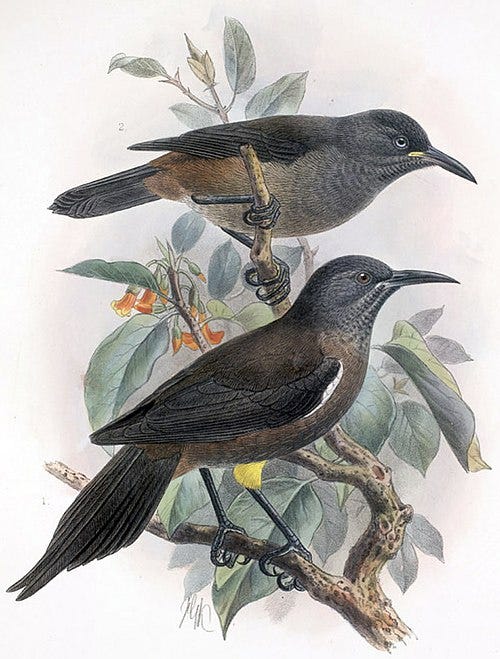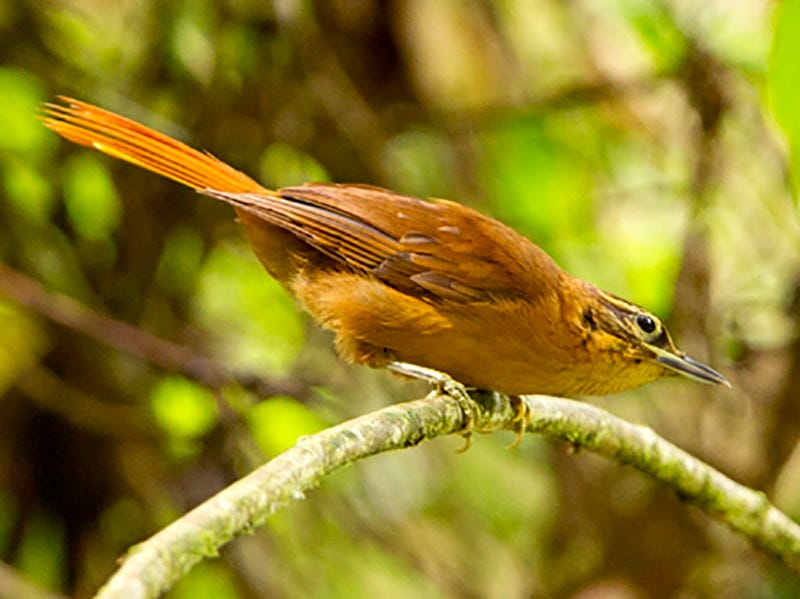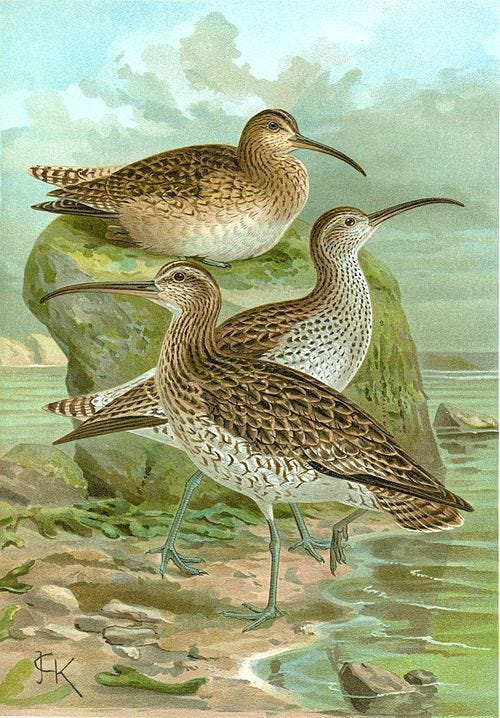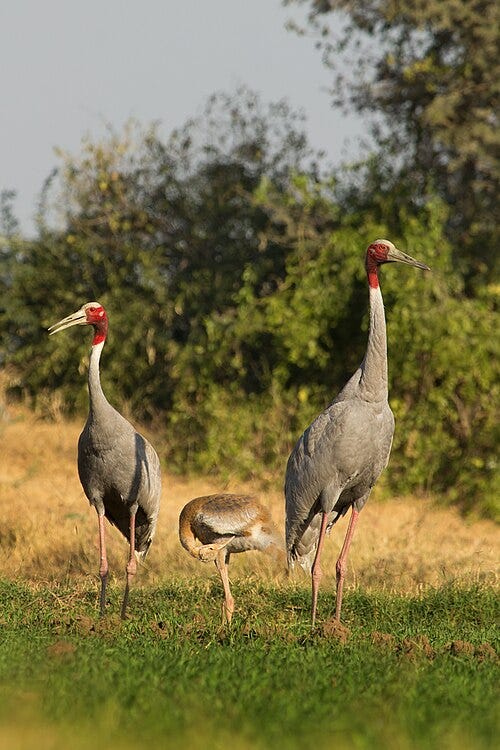A Gallery of Lost Voices
An article for Marjorie Evasco, about the voices of four lost birds: the Kauaʻi ʻōʻō, the Alagoas foliage-gleaner, the slender-billed curlew, and the sarus crane.
This article was inspired by and written for the wonderful poet Marjorie Evasco, who bought me a coffee (and was the very first subscriber to ever do so!) She was pondering the last song of the Kauaʻi ʻōʻō, an extinct species of bird from Hawaii. As a result, I began wondering about the voices of other lost birds as well.
The Kauaʻi ʻōʻō

The memory of the extinct Kauaʻi ʻōʻō (Moho braccatus) survives through song.
As the 19th century drew to a close, the graceful Kauaʻi ʻōʻō, a small black-feathered honeyeater endemic to the Hawaiian island of Kauaʻi, thrived throughout its forested home. Then Queen Liliʻuokalani was deposed and Hawaii annexed by U.S. marines; loggers arrived with saws and bulldozers; feral cats introduced by westerners decimated the native wildlife; invasive species of mosquitoes carried with them hitherto unknown diseases from the mainland, including a form of avian malaria.
By 1981, only a single mating pair was left. A hurricane then felled the couple’s tree, likely killing the last female. The male was then heard, but not seen, in 1987, singing a ghostly mating call. It has not been heard from since.
Over the following decades scientists hoped and hoped, but by 2023 the entire species was declared extinct, joining every other species of Hawaiian honeyeater. The Cornell Lab of Ornithology gives a devastating summary: “Only the voice of the Kaua‘i ‘Ö‘ö was ever recorded, archived, and published, and it is probably the only Hawaiian honeyeater that has been heard by anyone now living.” The website of the of the International Union for the Conservation of Nature is even more hauntingly succinct: “None remain.”
I first learned of the tragedy of the Kauaʻi ʻōʻō through a short animated film on Youtube. Afterwards I kept hearing about the vanished species again and again, on social media and other corners of the internet, and always about that final recorded song, at once both a heartbreaking lament and an accusation.
The eradication of Kauaʻi ʻōʻō would be sin enough if it were the only bird to have ever gone extinct by human short-sightedness. It is not. What other avian souls have been swept clean from this earth until only their voices remained?
The Alagoas Foliage-gleaner

The Pernambuco Forests on the Atlantic coast of northeast Brazil once formed a continuous expanse of trees 40,000 km2 in extent. The tall evergreens reached all the way from the seas to the distant mountains, providing a habitat for many unique kinds of flora and fauna.
Today the verdant citadel has been reduced to a few straggling pockets of tiny forest. Over 90% of its original extent has been replaced by sugarcane plantations and cattle ranches. The casualties have been enormous, particularly for Phylidor novaesi, the Alagoas foliage-gleaner, named after the late Brazilian ornithologist Fernando de Costa Novaes.
The Alagoas foliage gleaner was first described by taxonomists in 1979, as scientists noticed the staggering amounts of biodiversity being lost in Pernambuco during the late 70’s. The newly christened bird, as the name implies, fed on invertebrates plucked from exposed leaves and branches, and flew with different kinds of birds as part of diverse mixed-species flocks.
At the time of its description, the Alagoas foliage gleaner was still relatively common in the forest fragments where it could yet be found. But as even those fragments were cut down, the bird quickly vanished as well.
Scientists monitoring the situation eventually resorted to broadcasting playbacks of the species’ own voice, trying to attract any foliage-gleaner which would listen. Up to four individuals were recorded in a small private reserve last 2003. Another was caught on film last 2011. A tour group reported seeing a single individual in 2012. No other sightings have been made since.
Subsequent attempts at playback failed to locate any surviving individuals, but did attract other kinds of birds, including antwrens, which used to flock with the Alagoas foliage-gleaner. Maybe these strangers were drawn by the calls of missing friends. As other authors have said, perhaps the Alagoas foliage-gleaner “persisted… in the living memory of these would-be co-members of mixed-species flocks.”
The Alagoas foliage-gleaner was declared extinct in 2019, following the lack of any sightings and the near-complete decimation of its former forest habitat in the Pernambuco after 2012.
The Slender-billed Curlew

Until recently, there have only been two known extinctions of birds from the Western Palearctic, meaning Europe, North Africa, and parts of the Middle East up to the Caspian Sea. This includes the Canarian oystercatcher, which in the past inhabited the Canary Islands of Spain, and the great auk, which formerly swam the entire North Atlantic, until it was hunted to extinction for its prized down.
Then in 2024, the slender-billed curlew (Numeinus tenuirostris) was added to the list. The migratory shorebird once wintered around the Mediterranean, but could also be found in other parts of Europe and the Middle East, frequenting coastal lagoons and similar wetlands. Where it spent the breeding season is mostly a mystery; the only confirmed breeding ground was recorded in 1925 in Omsk, Russia.
Indeed, much about the species remains unknown. Scientists aren’t even sure about the exact causes of its decline, which may have been caused by a mix of widespread habitat loss and hunting. Concerns about the curlew’s possible disappearance were raised as early as a 1912 publication by a Russian ornithologist. Action came too late, however. The last documented sighting of the slender-billed curlew was taken in Merga Zerga, Morocco, in 1995. After almost three decades without any reliable observations, a team of scientists declared the slender-billed curlew extinct in 2024.
We only have one known audio record of the slender-billed curlew, that of a male calling while in flight, recorded last 1990 in Merga Zerga, Morocco.
The Sarus Crane

The sarus crane (Grus Antigone) is one of the tallest birds in the world. At full height it can standas tall as a human. They use their long necks and bills to probe the shallow waters of their wetland homes for small frogs, insects, and fish.
Historically, the sarus crane was found throughout India and Southeast Asia all the way to northern Australia. It still exists in the Ganges plains, as well as portions of Thailand and Myanmar. It was also once found in the Philippines, particularly in the swamps of Luzon. Here is a link to a 19th century illustration of the sarus crane standing next to a man wearing a salakot, painted by Filipino painter Jose Honorato Lozano, in a thoroughly researched article by writer and ornithologist Christian Perez.
Filipinos in the past would have heard the strange trills and trumpeting yells of the sarus crane as they wandered the wetlands of 19th century Luzon. But today the species has vanished from the Philippines, and Filipinos wanting to hear its voice must either scour the internet for a recording, or book a plane ticket to those countries where the giant crane still exists.
Postscript
We rarely have audio recordings of extinct species. Most have simply passed silently into the night, leaving only their bones or stuffed museum skins for us to woefully ponder.
All the more reason, then to protect all the feathered souls that still remain. Because even with recordings, the best way to listen to a bird is in person, under the great blue sky.





Daghang salamat, Rio. I love your story of the voices of four lost birds, their song-language lost to us forever. This story honors them and somehow brings them back to our consciousness. Padayon! -- Manding Joray